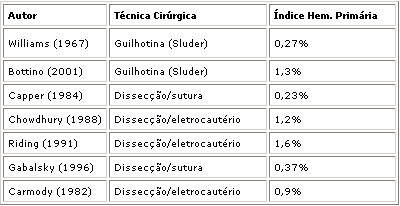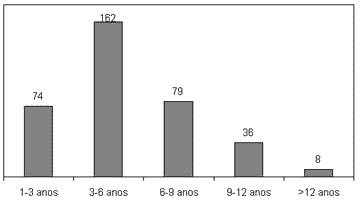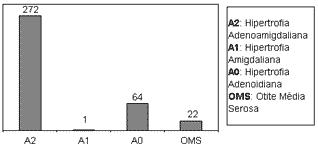

Year: 2003 Vol. 69 Ed. 3 - (8º)
Artigo Original
Pages: 338 to 341
Hemorrhage in adenoidectomy and/or tonsillectomy: 359 cases review
Author(s):
Fernando M. J. Vieira[1],
Flávia L. Diniz[2],
Cláudia R. Figueiredo[3],
Luc L. M. Weckx[4]
Keywords: adenoidectomy, tonsillectomy, post-operatory hemorrhage, post-operatory complications.
Abstract:
Introduction: Historically, adenoidectomy and tonsillectomy are the most frequent surgical procedures done by otorhinolaryngologists, and more often in the pediatric population. The most frequent and most serious complication related to these procedures is the hemorrhage in the post-operatory period. Study Design: Clinical prospective. Aim: To evaluate the occurrence of the most common surgical complication of the procedure: post-operatory hemorrhage, contributing to the handling of this potentially fatal complication. Method: We prospectively analyzed all children submitted to adenoidectomy and/or tonsillectomy at the Pediatric Otorhinolaryngology Discipline of the Federal University of São Paulo from March 2001 to March 2002. Results: 359 cases of adenoidectomy and/or tonsillectomy were included in this study. Post-operatory hemorrhage was observed in 3 cases of combined adenotonsilectomy, all of them in the first 24 hours after the surgical procedure. Conclusion: We observed that 3 cases of post-operatory hemorrhage have occurred, representing an incidence of 0,8%.
![]()
LITERATURE REVIEW
Tonsillectomy and adenoidectomy are among the most frequent ENT procedures. Among the indications for adenoidectomy, we can include marked hyperplasia of the lymphoid tissue, with consequent oral breathing and uncontrollable secretory otitis, repetitive acute otitis media and difficult to control nasosinusal infections 1.
Among the indications to tonsillectomy, we can include repetitive and difficult to control acute infections, peritonsillary abscess and marked hyperplasia 1.
Among the complications of these procedures, postoperative bleeding, called primary if within 24 hours after the procedure is one of the main events1, 2. Peeters et al. reported fatal cases of postoperative hemorrhage both after hypovolemia and hyponatremia after incorrect correction of volemia 3.
Among the various surgical techniques available, mechanical dissection, the use of electrocautery or guillotine, there is little difference concerning hemorrhage indexes 4, 5, 6.
Currently, we discuss and employ adenotonsillectomy as a procedure that is conducted with one-day hospitalization, owing to the safety is provides 7. It is also discussed what medications, such as antibiotics and corticoids should be used postoperatively to reduce patients' discomfort and provide quicker return to daily activities 8, 9.
INTRODUCTION
Adenoidectomy and tonsillectomy are historically the surgical procedures most commonly performed in the ENT specialty, having its main incidence in the pediatric population. At the beginning of the 20th century, there was a boom in the use of such surgeries, being more frequently conducted in the presence of minimum symptoms. As of the 60's, as a result of the advance in immunology, a movement towards standardizing and defining the precise indications to the surgery gained momentum. It has been observed a decline in the use of these surgeries, but despite this tendency, they are still the most frequent surgical procedures performed.
The main indications for the conduction of adenoidectomy and tonsillectomy are recurrent infections and upper airway obstructions, which may lead to recurrent sinusitis, repetitive otitis media, snoring and apnea. Adenoidectomy is indicated when hypertrophy obstructs over 80 to 90% of the nasopharynx lumen, being responsible for affecting the cranial facial growth, known as the Mouth Breathing Syndrome 1.
Tonsillectomy also has precise indications for its conduction. Among them, we can include repetitive tonsillitis, which can impair school activities and children's development, non-responsive tonsillary hypertrophy, together with snoring, oral breathing, and sleep apnea, and peritonsillary abscesses 1.
Despite the main use of adenoidectomy and tonsillectomy in our centers, these procedures are not free from complications. Among them, we can highlight postoperative hemorrhage as the most frequent and severe one, which can be fatal in some specific cases 1, 6, 5.
The purpose of the present study was to contribute to the knowledge of the frequency of intraoperative and early postoperative bleeding, analyzing the frequency of hemorrhagic episodes, the need for hemostatic procedures, surgical reintervention and blood transfusion.
MATERIAL AND METHOD
To conduct the present study, we analyzed prospectively all children submitted to adenoidectomy and tonsillectomy at the Discipline of Pediatric Otorhinolaryngology of UNIFESP/EPM between March 2001 and March 2002, conducted at Hospital São Paulo.
In all cases, the physicians ordered complete blood count and coagulation times before the surgery. Parents were informed about the risks of the procedure and signed the informed consent form, as provided by the Brazilian Society of Otorhinolaryngology (SBORL).
All surgeries were conducted under general anesthesia and orotracheal intubation and the employed technique was mechanical dissection of tonsillary tissue and curettage of the adenoid tissue with Beckman curette. The hemostasis was conducted with simple separated stitches with categut 2.0.
Surgeries were performed by resident and specialization physicians in Otorhinolaryngology of Hospital São Paulo, under the supervision of their preceptors.
RESULTS
We included in the study 359 patients submitted to adenoidectomy and/or tonsillectomy, 189 were male (52.6%) and 170 were female (47.4%) patients (Graph 1). The mean age was 5.8 years, ranging from 1 year and 9 months to 17 years.
Among the 359 procedures, there were 89 adenoidectomies, 1 tonsillectomy and 269 adenotonsillectomies. In 15 cases, we placed ventilation tympanic tubes during the surgery owing to secretory otitis media.
The main surgical indication was pharyngeal tonsil hypertrophy in 64 cases, tonsil hypertrophy in 01 case, adenotonsillary hypertrophy in 272 cases and secretory otitis media in 22 cases (Graph 3).
We detected primary postoperative hemorrhage (within 24 hours after the procedure) in 3 children. In the first case, there was postoperative hemorrhage 6 hours after adenoid curettage, solved by applying posterior nasal packing. The packing was removed 24 hours later and there were no further complications.
In the second case, there was massive hemorrhage 12 hours after the surgical act, requiring hemostasis under general anesthesia. There was one hemorrhagic episode within the first 24 hours, requiring a new surgical revision and administration of a unit of red blood cell concentrate for the appropriate hemodynamic balance. There was no further hemorrhage later; the case is currently being investigated by the Hematology department of UNIFESP/EPM.
The third case we observed with postoperative hemorrhage was 8 hours after adenoid curettage; we placed posterior nasal packing, leading to appropriate control of bleeding. The packing was removed 24 hours later without further complications.
Upon analyzing the data, we concluded that there was an incidence of 0.8% of bleeding complications in the early postoperative period.Table 1. Hemorrhage after adenoidectomy in children.Table 2. Hemorrhage after tonsillectomy in children.Graph 1- Distribution of patients submitted to surgery according to genderGraph 2- Distribution of operated cases by age rangeGraph 3- Surgical indication by number of operated cases
DISCUSSION
Once we acknowledge the great role and the high frequency of these procedures, it is essential to anyone who plans to execute them to be aware of the possible complications and episodes that he or she may face.
Among the intra and postoperative complications, hemorrhage is one of the most frequent ones and poses risks to the patient's life, therefore, its control is essential. It is named primary if present within 24 hours after the procedure 3.
Intra and postoperative bleeding can be minimized by investigating family and personal history, suspending medications that may affect blood coagulation or platelet aggregation and require coagulation time test. The importance of requiring tests that value the cascade of coagulation is demonstrated in the present study. The second case of hemorrhage required new surgical intervention and blood transfusion, but there was no family history of hemorrhagic disease and, preoperatively, the test of coagulation and bleeding times were within the normal ranges. The activity of pro-thrombin was 71.8% with INR of 1.26, but activated thromboplastin time was 46.1 (normal within 25 and 35) and even so he was submitted to the procedure. One year and 3 months later, the patient is still being studied in the Hematology department and the values of APTT are abnormal but with no defined diagnosis yet. The literature reports an incidence of postoperative primary hemorrhage in children that ranges from 0.1% to 1.4% after adenoidectomy and 0.23% to 1.6% after tonsillectomy, according to the Tables shown below.
In our study, the three reported cases represented an incidence of 0.8% of primary postoperative hemorrhage, which is in accordance with the studied literature.
Peeters et al. 3 suggested still another classification for minor and major hemorrhages, classifying as major hemorrhage the cases in which they require blood transfusion and/or hemostatic revision under anesthesia. According to this criterion, the index of major hemorrhage in our sample was only 0.27%.
In this study, the three cases with postoperative hemorrhage we detected were in patients submitted to adenotonsillectomy, being that the mild ones originated from the adenoid tissue and the major one from the tonsillary site. There was no case of bleeding after isolated adenoidectomy or tonsillectomy.
Pain, fever and vomiting can lead to dehydration, another early postoperative complication that should be treated with appropriate replacement of fluids and electrolytes. Some authors advocate the routine use of antibiotics in order to reduce pain and fever, preventing dehydration and promoting a quick return to habitual diet.
There are many studies in the literature about the importance of complications after the procedure, reporting even fatal cases 3. Therefore, it is essential to know the appropriate indications, the technique and the possible adverse events of the surgery, so as to have a safe environment to the physician and the patient.
CONCLUSION
Adenotonsillectomy is a safe procedure, with precise indications, but is not free from complications, being postoperative hemorrhage one of the most frequent ones. In our sample, the incidence of this event was 0.8% being that in only one case it required new surgical intervention.
REFERENCES
1. Otacilio e Campos. Tratado de Otorrinolaringologia. Editora Roca; 1994.
2. Peeters A, Katz S. Tonsillectomy and adenoidectomy as a one day procedure? Acta Otorhinolaryng Belg 1999;53.
3. Peeters A, Saldien V. Lethal complications after tonsillectomy. Acta Otorhinolaryng Belg 2001;55.
4. D´Avila J, Naves AB, Sobral HAC. Adenoidectomia: Novos princípios. Estudo interdisciplinar. Rev Bras Otorrinol Nov/Dez 1999;65(6).
5. Bottino MA, Souza JCR, Martinelli RB. As vantagens do Sluder na amigdalectomia Arc Otorrinolaringol 2002;6(1) 51-3.
6. Stanislaw Jr. P, Feustel PJ. Comparison of power-assisted adenoidectomy vs. adenoid curette adenoidectomy. Arch Otolaryngol Head Neck Surg July 2000;126.
7. Tewary AK. Day-case tonsillectomy: a review of the literature. Journal of Laryng and Otology Aug 1993;107.
8. Colreavy MP, Cafferkey M. Antibiotic prophylaxis post-tonsillectomy: is it of benefit? Int Journal of Ped Otorhin 1999;50.
9. Hengerer AS. Do intravenous steroids play a role for tonsillectomy patients? Arch Otolaryngol Head Neck Surg Aug 2001;127.
1 - Physician, Federal University of São Paulo.
2 - Master studies to be approved at UNIFESP-EPM.
3 - Master in Otorhinolaryngology, UNIFESP-EPM.
4 - Full Professor, UNIFESP/EPM.
Address correspondence to: Fernando M. J. Vieira - Rua Sararé, 287 ap.101 SP 05452-010
Tel (55 11) 3021-1081 / 9915-1389 - E-mail: fvieira65@uol.com.br
The author was financially supported by PIBIC (Programa Institucional de Bolsa de Iniciação Científica), CNPq, for the conduction of the present study.
This study was presented at X Congresso de Iniciação Científica da UNIFESP/EPM, held in São Paulo, October 01 - 02, 2002. Annals page 118




